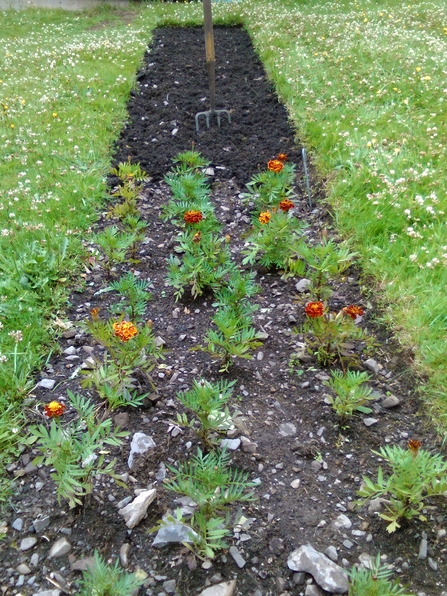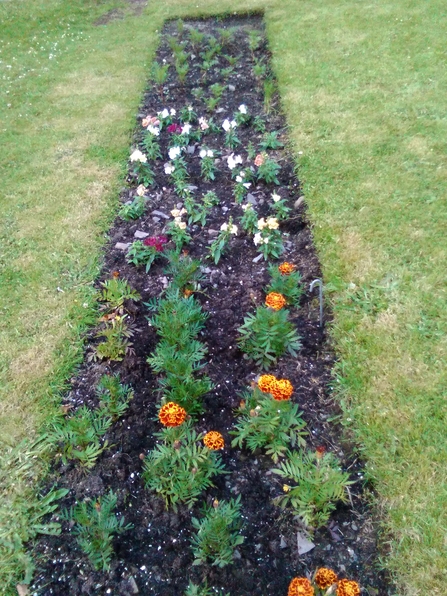Developing a flowering annual border with plant selections for wildlife is a great way to attract bees, butterflies and hoverflies into the garden. We have created this block planting space through the centre of our sloping lawn by slicing and removing the turfs.
Annual flowering border for pollinators by Kevin Line
French marigold ©Kevin Line

Annual flower border ©Kevin Line
The seasonal flowers comprise, Cosmos, Antirrhinums, and French Marigolds. I have grown the French marigolds from seed. These plants are nice free germinating plants to propagate for summer displays in the wildlife garden. Seeds were sown on 16th April, left in the cold frame for frost protection, then planted out on 20th June.
The emphasis of this annual flowering bed is to encourage the insect life into the open flower structures, in particular the Cosmos, which have yet to flower. Already at this stage I have recorded a number of Meadow Brown butterflies on the Antirrhinums, and even a good number of hoverflies delving into the structure of the Cosmos plants. So even before the flowering process these plants hold some appeal for the hoverflies. It could be the aroma of the foliage?
French Marigolds are an excellent nectar source to attract butterflies and bees. There is the likelihood that some of the Marigolds could succumb to slug attack. As we are gardening for wildlife, as difficult as it is, I have no wish to harm the slugs. Firstly, it should be mentioned that despite the downsides, slugs are beneficial in decomposing organic matter and recycling nutrients; this is all part of the wildlife garden process.
Slugs can be deterred from damaging the plants by placing grit sand or horticultural grit around the base. We keep ex battery rescued hens and so I sprinkle a mix of chick grit and oyster shell around the plants. These two compositions are used for the digestive system of the hens, the slugs dislike the sharp gritty feel. There are also a good number of organic wildlife friendly products available on the market. Any garden rich in wildlife will also attract the birds to take nature’s fill of the slugs, and the declining hedgehog will follow suit.
At the edges of the annual flowering display for pollinators I undertake a close cut with the mower about an 18 inch width to define the border. This is carried out with a small versatile battery-operated mower which for our garden lawn space is more environmentally friendly. Beyond this closely mown strip of grass the lawn is just cut high once a month which allows any wild flowers to return in a short space of time, and keeps it tidy, but not too tidy.

Annual flower border planted ©Kevin Line
Our lawn slope comprises mainly of White clover (Trifolium repens). This flower is native to Europe and the British Isles and central Asia, it is the most widely cultivated species of clover. White clover attracts a host of beneficial insects which include bumblebees, butterflies, honeybees, all of this wildlife are drawn into the good pollen and nectar count. Allowing the clover to keep repeat flowering during the growing season is a great way to maximise gardens for bee food diversity.
I have also learned that taking the top of the clover off once a month with the mower improves the ongoing flower quality. This in turn improves the influx of insects which also includes hoverflies.

